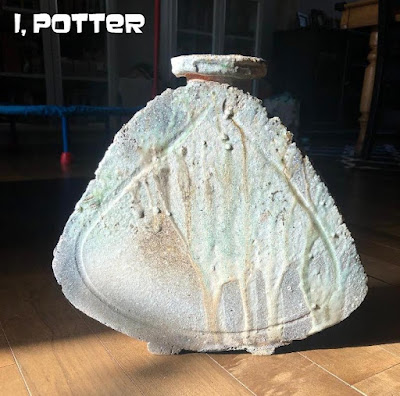Illustrated is a rather well salt fired cobalt bottle faceted across for planes that shows a rather diverse topography of depth of color and texture. Beyond the color and texture the neck and mouth are perfect and ringed by a wet ring of slat that varies in color and the foot is crisply and expertly cut and flanked by his personal mark and the mark of his pottery. Having some personal insight into a potter leads to a deeper connection with the pot and at times helps answers regarding the how and why certain details are the way they are and to be perfectly honest it really doesn't hurt knowing that both Phil and I were looking at exactly the same pots which make their way in to our pots even if it doesn't look like it.
Wednesday, September 29, 2021
FACETED BLUE
Monday, September 27, 2021
FIVE BY FIVE
Friday, September 24, 2021
MORE IS ALWAYS BETTER
This morning I happened to spot a rather familiar looking Iga henko form on Instagram and that made me go back and look through my archive of photos on the hard drive to come up with this particular photo. As I mentioned, the two pieces could in fact be from the same series made within hours or days of each other and both fired in the same kiln but that being posited the truth is that I have now seen five of these forms by Iga potter, Imura Mitsuo who learned a great dealer from his teacher, Sugimoto Sadamitsu an influence that is easy to see in how the clay is handled and the pots are fired. As for the five similar henko, two were in catalogues/ magazines, one was shared by a friend over the internet, two of the pieces were seen in hand and lastly there was the one this morning on Instagram. Now if the math doesn't add up in your book that is because this piece is also one of the two illustrated in a catalogue, just wanted to get that out in the open.
This Iga henko is a perfect size, it is about 14" or so long and was made with a wonderful taper moving toward the sides emanating out from the well considered and crumbly style texture to the mouth. Perhaps one rather interesting feature to this piece as with most that I have seen it that it was fired on their sides allowing for the ash built up during the firing to cascade down the surface making for a rather dramatic and effective look on the pot. The surface of the piece is a wonderful narrative of the possibilities of firing from a bit of hiiro fire color to green glass like ash, long, determined ash flow and areas of carburized surface where charcoal built up around the base of the pot as it was fired telling its story of creation. All in all, the form of this henko by Imura Mitsuo works very well with the manner in which it was fired with its varied surfaces, well enough I should say that there are a number of these pots floating around out there and if one is good, more is always better.
Wednesday, September 22, 2021
A SMALL GLIMPSE OF DAI-KANNYU
Up next at I,Potter TV, well on Youtube to be fair is this splendid Yamato Yasuo Dai-Kannyu (kairagi) Hagi guinomi. I made this short video slideshow using what details I thought best captured the essence of this diminutive but impactful guinomi giving a small glimpse of dai-kannyu in the round. The dai-kannyu, big cracks are certainly front and center on this piece and rather hard to miss with a surfacethat looks very different under varying light sources. There is a real beauty to the soft multi-layered appearance of the Hagi glaze that is almost brutally interrupted by the deep, tactile fissures that define Yamato Yasuo's dai-kannyu pottery of which this is just a very small example but illustrative of the effect and process that he has embarked upon. Enjoy the video.
Monday, September 20, 2021
FLOODED
Friday, September 17, 2021
OGAWA MISHIMA
Wednesday, September 15, 2021
SPHERES
Monday, September 13, 2021
A (BASE) GLAZE ODYSSEY
(*The original formula of this base glaze was given to me by a potter while I lived in Cleveland though I never used it at that time. Years later when I moved here to central NY State I finally tested it and didn't like it right out of the box so I kept modifying it until it suited my needs. I think at this point the formulas are significantly different but without his generosity the odyssey that is this base would likely have never happened.)
Friday, September 10, 2021
TMC
Wednesday, September 8, 2021
NUANCED DETAILS
Starting with the design of the piece which is at its core simple and a homerun of nuanced details, the pot is easy to make and use with visual particulars including the angled corners and raised ridges create an interest in the surface before the glaze is even applied. Once the ash glaze is used Kawai Takeichi ladled over a rich tessha that when fired has added movement and life to the hachi without any fuss or superfluous additions. In the end learning good and practical design from a master like Kawai Kanjiro certainly can not hurt in one's pursuit of creating work based on a tradition while spreading one's wings to make work that is more about the student than the master.











